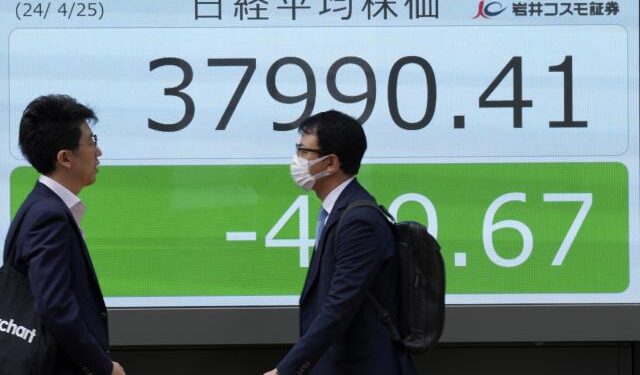Asian stock markets opened sharply lower today, April 11, 2025, as investor sentiment soured in response to renewed tensions between the United States and China. The dramatic market swings underscore the fragility of global confidence in an increasingly protectionist trade environment and signal a volatile day ahead for the global economy.
The declines were led by Japan’s Nikkei 225, which tumbled 5.6%, reversing gains from earlier in the week. South Korea’s Kospi slipped 1.3%, Australia’s ASX 200 dropped 1.2%, and Hong Kong’s Hang Seng Index fell by more than 1%. The sell-off came just hours after U.S. President Donald Trump unveiled sweeping new tariffs of up to 145% on Chinese imports, escalating what analysts are now calling a full-blown trade war.
The market shockwave reverberated beyond equities. Gold prices surged past the $3,200-per-ounce mark for the first time in history, peaking at $3,219.84 in early trading. Spot gold was up 1.4% at $3,217.78, while U.S. gold futures jumped 1.9% to $3,237.50. Investors have rushed into the traditional safe haven in response to the deteriorating geopolitical landscape, a weakening U.S. dollar, and expectations that the Federal Reserve may pivot to rate cuts to cushion the economy.
Market analysts point to a perfect storm of factors driving the precious metal’s meteoric rise: central bank stockpiling, surging demand for gold-backed ETFs, and fears that inflation could resurface if trade disruptions spill into consumer prices. With global supply chains already strained, the tariff hikes are expected to reverberate across multiple sectors, further clouding the economic outlook.
Meanwhile, the currency markets were also roiled. The dollar weakened significantly against a basket of major currencies, while the Japanese yen and the euro gained ground. China’s yuan tumbled to a 19-month low, prompting speculation that Beijing may roll out fresh economic stimulus in the coming weeks to offset the blow.
In the bond markets, the U.S. 10-year Treasury yield climbed to 4.475%, marking its sharpest weekly increase since 2001. The yield spike reflects investor uncertainty over inflation and central bank policy, with many now pricing in a reversal of the Fed’s previous tightening stance.
Looking ahead, global markets are expected to remain jittery throughout the day. European markets are poised to open lower, and early indicators suggest that Wall Street may also see red when trading resumes. Economists warn that a prolonged trade war between the world’s two largest economies could shave significant points off global GDP growth in 2025.
The volatility speaks to a broader reality: the global economy remains deeply interconnected, and geopolitical disruptions in one region quickly echo across continents. As investors brace for more turbulence, the rush to safe assets and the retreat from riskier equities may define the tone of the financial markets in the days and weeks to come.
For now, all eyes are on the next moves from Washington and Beijing. Markets will be watching closely for signs of diplomatic engagement—or further escalation. Either way, today’s dramatic opening is a stark reminder of how quickly the winds of global finance can shift.
editorial newshub-finance

